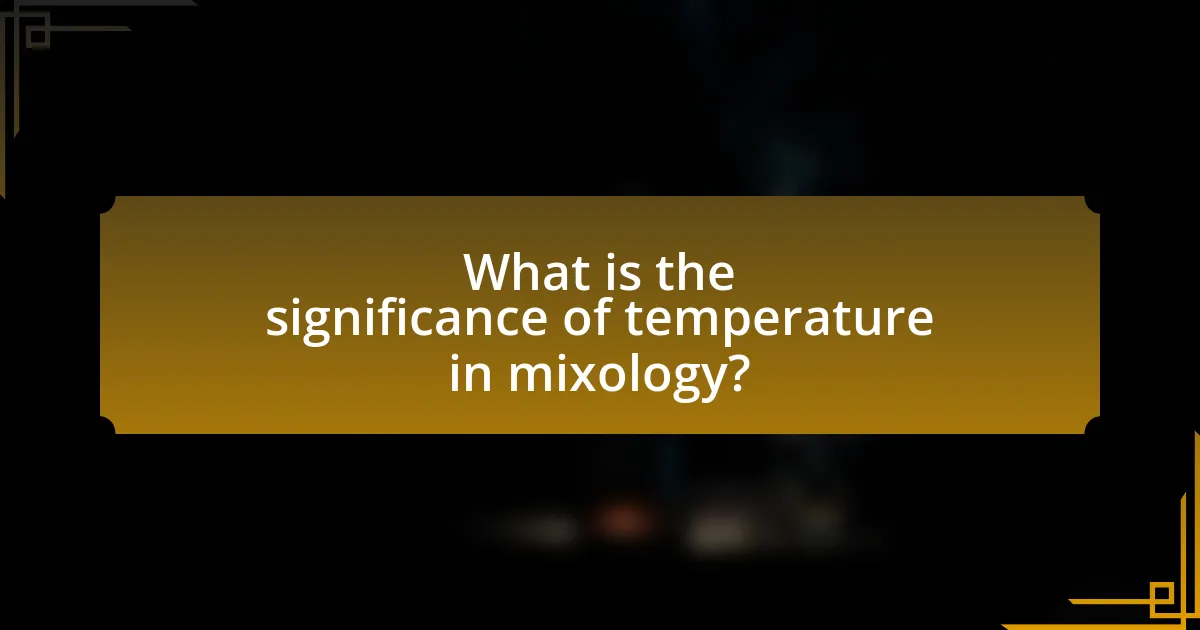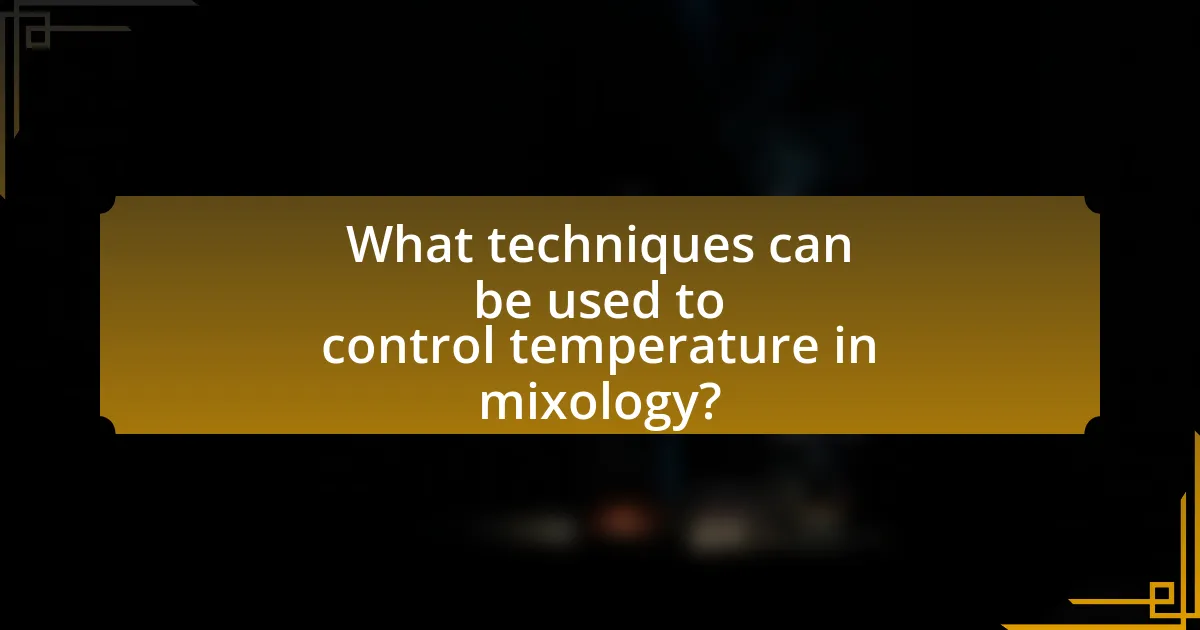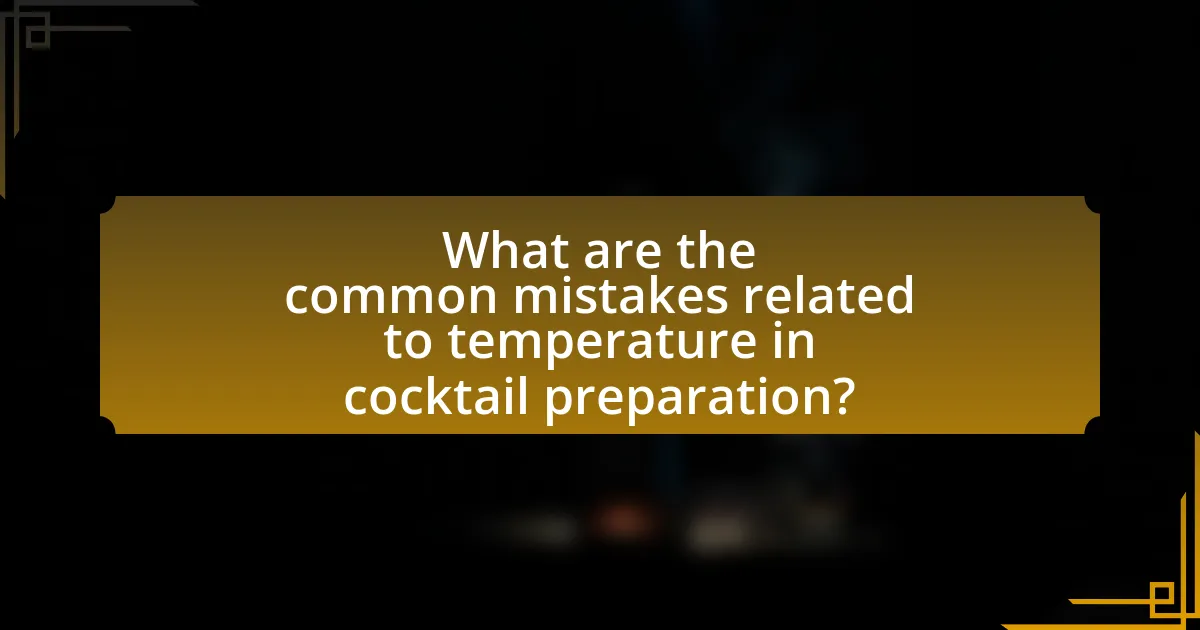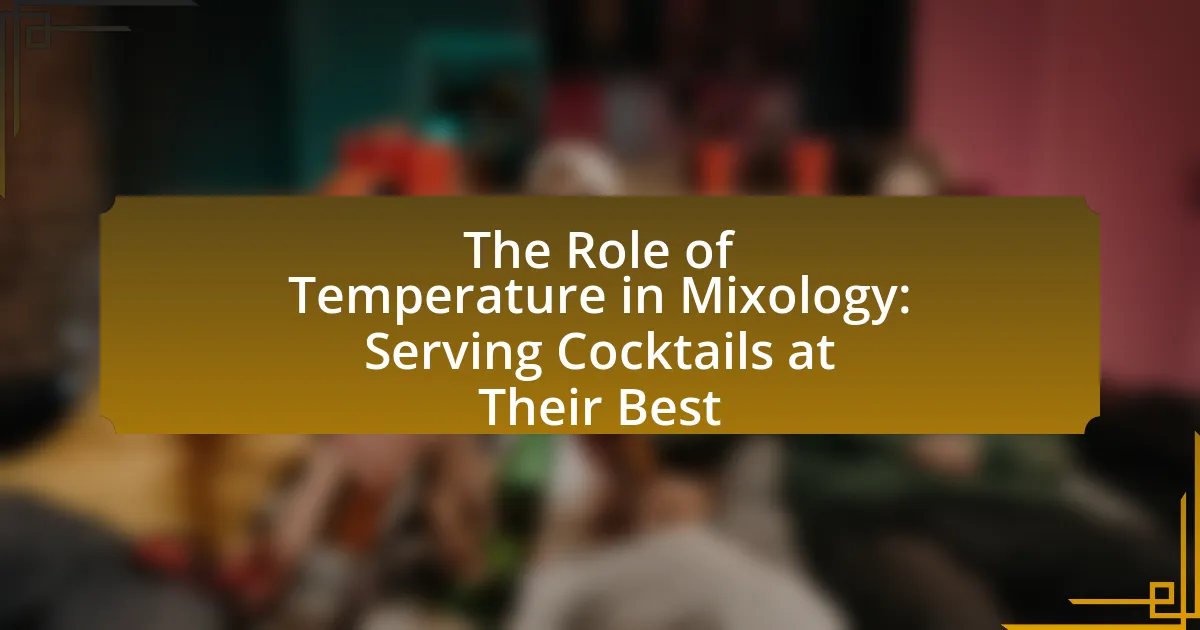The article focuses on the significance of temperature in mixology, emphasizing its impact on the flavor, aroma, and overall experience of cocktails. It explores how temperature influences taste perception, including sweetness and bitterness, and discusses the chemical reactions that occur at different temperatures. The article outlines the ideal serving temperatures for various cocktail categories, the effects of temperature on dilution, and techniques for controlling temperature in cocktail preparation. Additionally, it highlights common mistakes bartenders make regarding temperature and offers best practices for serving cocktails at their optimal temperatures to enhance the drinking experience.

What is the significance of temperature in mixology?
Temperature is significant in mixology because it directly influences the flavor, aroma, and overall experience of cocktails. Cold temperatures enhance the refreshing qualities of drinks, while warmer temperatures can amplify certain flavors and aromas. For instance, serving a cocktail too warm can lead to a loss of carbonation and a change in taste profile, while chilling ingredients can help maintain balance and complexity. Studies have shown that temperature affects the solubility of gases in liquids, which is crucial for carbonated beverages, as well as the volatility of aromatic compounds, impacting how flavors are perceived by the palate.
How does temperature influence the flavor of cocktails?
Temperature significantly influences the flavor of cocktails by affecting the perception of taste and aroma. When cocktails are served cold, the lower temperature can suppress sweetness and enhance refreshing qualities, making the drink feel crisper. Conversely, warmer temperatures can amplify sweetness and allow more complex flavors and aromas to emerge, which can lead to a richer tasting experience. Research indicates that temperature can alter the volatility of aromatic compounds; for instance, a study published in the Journal of Agricultural and Food Chemistry found that certain volatile compounds are more pronounced at higher temperatures, thus enhancing the overall flavor profile of the cocktail.
What chemical reactions occur at different temperatures in cocktails?
Chemical reactions in cocktails vary with temperature, primarily affecting the solubility of ingredients, the rate of oxidation, and the volatility of aromatic compounds. At lower temperatures, such as when cocktails are chilled, the solubility of sugar and other solutes increases, enhancing sweetness and flavor integration. Conversely, higher temperatures can accelerate oxidation reactions, which may lead to undesirable flavors and aromas, particularly in cocktails containing fresh ingredients like citrus or herbs. Additionally, elevated temperatures increase the volatility of aromatic compounds, resulting in a more pronounced aroma but potentially altering the balance of flavors. These temperature-dependent reactions are crucial for achieving the desired taste and aroma profiles in cocktails.
How does temperature affect the perception of sweetness and bitterness?
Temperature significantly influences the perception of sweetness and bitterness in beverages. As temperature increases, sweetness perception tends to enhance, while bitterness perception often diminishes. Research indicates that warmer temperatures can amplify the release of volatile compounds that contribute to sweetness, making sweet flavors more pronounced. Conversely, higher temperatures can suppress the bitterness of certain compounds, leading to a more balanced flavor profile. A study published in the journal “Food Quality and Preference” by researchers at the University of California found that participants rated sweet beverages as sweeter and bitter beverages as less bitter when served at higher temperatures, confirming the impact of temperature on taste perception.
Why is serving temperature important for different types of cocktails?
Serving temperature is crucial for different types of cocktails because it directly influences the flavor profile, aroma, and overall drinking experience. For instance, chilled cocktails, such as martinis, enhance the crispness and balance of flavors, while warmer cocktails, like hot toddies, emphasize comforting spices and aromas. Research indicates that temperature affects the volatility of aromatic compounds; colder temperatures can suppress certain flavors, while warmer temperatures can enhance others, leading to a more enjoyable sensory experience. Therefore, serving cocktails at the appropriate temperature ensures that the intended taste and aroma are fully realized.
What are the ideal serving temperatures for various cocktail categories?
The ideal serving temperatures for various cocktail categories are as follows:
- Cocktails served straight up, such as martinis and daiquiris, are best served between 38°F to 45°F (3°C to 7°C).
- Cocktails served on the rocks, like whiskey sours and mojitos, should be served at approximately 45°F to 50°F (7°C to 10°C).
- Highball cocktails, including gin and tonics, are ideally served at around 45°F to 55°F (7°C to 13°C).
- Warm cocktails, such as hot toddies, are best enjoyed at temperatures between 130°F to 160°F (54°C to 71°C).
These temperature ranges enhance the flavors and overall drinking experience of each cocktail category.
How does temperature impact the dilution of cocktails?
Temperature significantly impacts the dilution of cocktails by influencing the rate at which ice melts. When cocktails are served at lower temperatures, ice melts more slowly, resulting in less dilution and a more concentrated flavor profile. Conversely, higher temperatures cause ice to melt faster, leading to increased dilution and a more watered-down drink. Research indicates that a cocktail served at 0°C can maintain its integrity longer than one served at room temperature, as the melting rate of ice is directly proportional to the surrounding temperature. This relationship is crucial for mixologists aiming to balance flavor and temperature in cocktail preparation.

What techniques can be used to control temperature in mixology?
Techniques to control temperature in mixology include chilling, dilution, and temperature management of ingredients. Chilling can be achieved through methods such as using ice, refrigeration, or pre-chilled glassware, which helps maintain the desired temperature of cocktails. Dilution occurs when ice melts, which not only cools the drink but also balances flavors; this is particularly important in cocktails served over ice. Additionally, managing the temperature of ingredients, such as using room temperature spirits or chilled mixers, allows for precise control over the final drink temperature. These techniques are essential for enhancing the overall drinking experience, as serving cocktails at optimal temperatures can significantly affect flavor perception and enjoyment.
How can bartenders effectively chill cocktails?
Bartenders can effectively chill cocktails by using ice, pre-chilled glassware, and rapid chilling techniques. Ice is the most common method; it cools the drink quickly while also diluting it slightly, which can enhance flavor. Pre-chilling glassware, such as by placing glasses in the freezer or filling them with ice water before serving, ensures that the cocktail remains cold longer. Rapid chilling techniques, like using a cocktail shaker filled with ice or employing a blast chiller, can reduce the temperature of the drink in a matter of seconds. These methods are supported by the principle that lower temperatures enhance the perception of flavors and aromas in cocktails, making them more enjoyable.
What tools are essential for chilling cocktails quickly?
Essential tools for chilling cocktails quickly include a cocktail shaker, ice bucket, and a mixing glass. A cocktail shaker allows for rapid mixing and chilling of ingredients through agitation, while an ice bucket provides easy access to ice, which is crucial for cooling drinks efficiently. A mixing glass, often used with a bar spoon, enables the bartender to stir cocktails with ice, achieving optimal temperature and dilution. These tools are fundamental in mixology, as they enhance the overall drinking experience by ensuring cocktails are served at the ideal temperature.
How does ice quality affect the chilling process?
Ice quality significantly impacts the chilling process by influencing the rate of temperature reduction and dilution in beverages. High-quality ice, characterized by clarity and density, melts more slowly, providing effective chilling without excessive dilution. In contrast, low-quality ice, often cloudy and less dense, melts quickly, leading to rapid dilution and a compromised flavor profile in cocktails. Studies have shown that the melting rate of ice can vary significantly based on its structure, with clear ice melting approximately 20% slower than cloudy ice, thereby maintaining the intended taste and temperature of the drink.
What methods can be employed to serve cocktails at the right temperature?
To serve cocktails at the right temperature, bartenders can utilize methods such as chilling glassware, using ice in the mixing process, and employing temperature-controlled storage. Chilling glassware, for instance, can be achieved by placing glasses in a freezer or filling them with ice water prior to serving, which helps maintain the cocktail’s temperature upon pouring. Additionally, incorporating ice during the mixing process not only cools the ingredients but also dilutes them slightly, enhancing the overall flavor profile while keeping the drink cold. Finally, storing ingredients like spirits and mixers in a refrigerator ensures they are at an optimal temperature before preparation. These methods are widely recognized in the industry for their effectiveness in delivering cocktails at the desired temperature.
How can glassware choice influence the temperature of a cocktail?
Glassware choice significantly influences the temperature of a cocktail by affecting heat transfer between the drink and its environment. Different materials, such as glass, metal, or ceramic, have varying thermal conductivity properties; for instance, metal conducts heat more efficiently than glass, which can lead to a quicker temperature change in cocktails served in metal containers. Additionally, the thickness of the glass can also play a role; thicker glass retains cold temperatures longer, while thinner glass allows for faster warming. Studies indicate that serving cocktails in chilled glassware can maintain lower temperatures for extended periods, enhancing the overall drinking experience.
What role does pre-chilling play in serving cocktails?
Pre-chilling plays a crucial role in serving cocktails by ensuring that the drink is served at an optimal temperature, enhancing flavor and overall enjoyment. When cocktails are pre-chilled, the ingredients are cooled before mixing, which helps maintain the desired temperature throughout consumption, preventing dilution from melting ice. Research indicates that serving cocktails at colder temperatures can enhance the perception of flavors, as colder drinks often mask bitterness and highlight sweetness, leading to a more balanced taste experience.

What are the common mistakes related to temperature in cocktail preparation?
Common mistakes related to temperature in cocktail preparation include serving cocktails too warm, using ice that is not cold enough, and failing to chill glassware. Serving cocktails at elevated temperatures can dilute flavors and alter the intended taste profile, as many cocktails are designed to be enjoyed cold. Using insufficiently cold ice can lead to quicker dilution, impacting the drink’s balance. Additionally, neglecting to chill glassware can result in a warm serving temperature, which detracts from the overall drinking experience. These mistakes can significantly affect the quality and enjoyment of cocktails, as temperature plays a crucial role in flavor perception and overall presentation.
What errors do bartenders make regarding cocktail temperatures?
Bartenders often make errors in cocktail temperatures by serving drinks either too warm or too cold. Serving cocktails at improper temperatures can negatively affect flavor profiles and overall enjoyment. For instance, cocktails like martinis are best served chilled, and if not properly chilled, they can taste flat and uninviting. Conversely, cocktails that require ice, such as a mojito, can become overly diluted if served too cold or with excessive ice, leading to a loss of flavor intensity. Proper temperature management is crucial, as studies show that temperature can influence taste perception, with colder temperatures often dulling sweetness and enhancing bitterness.
How can improper temperature affect cocktail consistency?
Improper temperature can significantly affect cocktail consistency by altering the dilution rate and the integration of ingredients. When cocktails are served too warm, the ice melts more quickly, leading to excessive dilution, which can weaken flavors and disrupt the intended balance of the drink. Conversely, if cocktails are served too cold, the chilling can inhibit the release of aromas and flavors, resulting in a less enjoyable tasting experience. Research indicates that optimal serving temperatures enhance the sensory perception of cocktails, ensuring that flavors are pronounced and well-integrated, thus maintaining the desired consistency.
What are the consequences of serving cocktails too warm or too cold?
Serving cocktails too warm can lead to a loss of flavor complexity and an unpleasant drinking experience, as higher temperatures can amplify the perception of alcohol and diminish the subtleties of the ingredients. Conversely, serving cocktails too cold can mask flavors and aromas, making it difficult for the drinker to appreciate the intended taste profile. Research indicates that optimal serving temperatures enhance the sensory experience; for example, spirits are typically best enjoyed between 50°F and 65°F, while cocktails with mixers are often served colder, around 30°F to 40°F. This temperature range ensures that the balance of flavors is preserved, allowing for a more enjoyable consumption experience.
What best practices should be followed for optimal cocktail temperature?
To achieve optimal cocktail temperature, serve cocktails chilled, ideally between 30°F to 40°F (-1°C to 4°C). This temperature range enhances flavor and aroma, making the drinking experience more enjoyable. To maintain this temperature, use chilled glassware, incorporate ice during mixing, and consider pre-chilling ingredients. Research indicates that cocktails served at lower temperatures can enhance the perception of sweetness and balance, as noted in studies on sensory evaluation in beverages.
How can bartenders ensure cocktails are served at their best temperature?
Bartenders can ensure cocktails are served at their best temperature by using chilled glassware and properly measuring ice. Chilling glassware before serving helps maintain the cocktail’s temperature, as a cold glass reduces heat transfer from the environment. Additionally, using the right amount of ice, typically one-third of the glass, allows for optimal dilution and cooling without over-watering the drink. Research indicates that cocktails served at ideal temperatures enhance flavor perception and overall enjoyment, making temperature management crucial in mixology.
What tips can enhance the overall cocktail experience through temperature control?
To enhance the overall cocktail experience through temperature control, serve cocktails at their optimal temperatures, which typically range from 32°F to 45°F for chilled drinks and 60°F to 65°F for spirits. This ensures that flavors are preserved and the drinking experience is enjoyable. For example, chilling glassware before serving can maintain the desired temperature longer, while using ice that melts slowly, such as large cubes or spheres, prevents dilution. Additionally, pre-chilling ingredients and using temperature-controlled tools like cocktail shakers can further enhance the cocktail’s quality. Studies show that temperature significantly affects taste perception, with colder temperatures often enhancing sweetness and masking bitterness, thus improving overall enjoyment.
